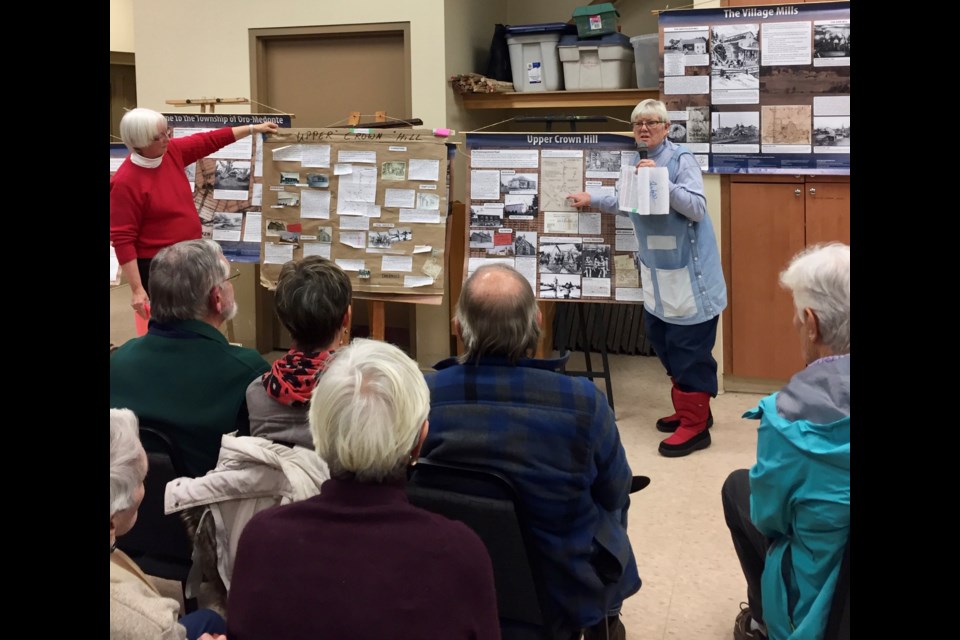NEWS RELEASE
ORILLIA MUSEUM OF ART AND HISTORY
******************
The Orillia Museum of Art and History (OMAH) hosted Joanna McEwen and Sheila Craig as guest speakers at the History Speaker Series recently.
They guided us on a spoken journey along the storied Penetanguishene Road, documented by superb story boards.
The audience was encouraged to do a field trip along Penetanguishene Road to see the historic signage.
Penetanguishene Road was the first road constructed in Simcoe County. As such, it was the main land artery for development of Simcoe County. A research project to document the road’s history in historic signage began in 2013, as a centenary celebration of the War of 1812, with a goal to gather information from communities along the road. It took four years to complete the research.
Historical record keeping by seven Women’s Institutes along the road, as documented in the Tweedsmuir Histories, were major sources. The team also accessed mementos, family records, personal diaries and various other materials.
Penetanguishene Road was needed as a direct route to the upper Great Lakes, to avoid going through the United States. The War of 1812 was brewing and there had been conflict since the American Revolution in 1777.
In 1808, Surveyor General of Canada Samuel Wilmot surveyed a road between Lake Simcoe and Penetanguishene Bay, which John Graves Simcoe had identified as a deep harbour for British ships. Surveyors laid out narrow 200-acre lots on either side of Penetanguishene Road. Since settlers were expected to keep the road in good repair, having many settlers in close proximity to the road was an effective strategy.
The end of the road was located in a spot on Lake Simcoe where boats could be brought in as easily as possible.
At Craighurst, formerly Morrison’s Corners, the Craigs provided a courthouse in their home, where the travelling judges visited, stayed and dined, when court was in session. We heard of a case being dismissed on the strength of advice from the host.
Construction of Penetanguishene Road required cutting down primordial forest. Lumbermen worked in winter to avoid mosquitoes and pulled gigantic stumps out of the ground using teams of oxen. Stumps were used for fences. The reputation of Mr. Davenport, a master chopper, and a wizard at squaring logs, endures. A person of colour, he was likely a veteran of the British forces, a United Empire Loyalist and a settler.
Forest clear-cutting created problems with water and soil management. Orr Lake became a sandy desert. Angus and Midhurst were deforested. Lumber barons saw reforestation as an infringement on their business rights, not their responsibility.
Reforestation was eventually conducted by Ontario’s premier, E.C. Drury, connecting present operations with history. Edmund Zavitz influenced Drury a farmer of Oro-Medonte, whose ancestors settled Penetanguishene Road, to begin reforestation. Today, Simcoe County profits by about $600,000 per year from harvesting reforested trees.
We thank Joanna McEwen and Sheila Craig for bringing the results of their research to us.
Join us at OMAH on Jan. 16 at 7:30 p.m for 'Fleeing Nazi Europe', a true tale of a family’s experience, told by Evelyn Ross, of Orillia. Also, tickets to the Sir John A. Macdonald Dinner being held at the Hawk Ridge Golf and Country Club on Jan. 12, 2019, are now on sale at OMAH. The tickets are $60 per person and payment can be made by cash, cheque or credit card. Tickets sold out before Christmas last year.
******************



